Design and Test of Seedbed Preparation Machine before Transplanting of Rapeseed Combined Transplanter
Abstract
:1. Introduction
2. Materials and Methods
2.1. Structure and Working Principle
2.2. Key Component Design and Parameter Determination
2.2.1. Rotary Tillage Blade Roller Design
- Rotation direction determination
- Blade arrangement of rotary tillage section
- Blade arrangement of ditching section
2.2.2. Structure and Parameter Design of Ditch Cleaning Shovel
- Structure design of ditch cleaning shovel
- Parameter design of arc radius
- Parameter design of arc central angle of soil entry section
- Parameter design of arc central angle of soil throwing section
2.2.3. Structure and Parameter Design of Soil Leveling Auger
- Structure design of soil leveling auger
- Parameter design of conveying value
- Parameter design of spiral blade diameter
- Parameter design of thread pitch
- Parameter design of the diameter of the auger shaft
2.3. Parameters Optimization Test of Seedbed Preparation Machine
2.3.1. Test Condition
2.3.2. Test Method
- Soil breaking rate
- Straw coverage rate
- Soil flatness
2.3.3. Test Factor
3. Results
3.1. Regression Equation Construction
3.2. Variance Analysis
3.3. Response Surface Analysis of Interaction Items
3.4. Test Verification
4. Conclusions
5. Discussion
Author Contributions
Funding
Institutional Review Board Statement
Data Availability Statement
Acknowledgments
Conflicts of Interest
References
- Wu, J.; Tang, Q.; Yuan, W.; Wang, S.; Wu, C. Design and parameter optimization of ditching and compacting parts of rapeseed carpet seedling transplanter. Trans. Chin. Soc. Agric. Eng. 2016, 32, 46–53. [Google Scholar]
- Jiang, L.; Wu, C.; Tang, Q.; Zhang, M.; Wang, G. Kinematics model and parameter optimization of planting process of rape carpet seedling transplanter. Trans. Chin. Soc. Agric. Eng. 2018, 34, 37–46. [Google Scholar]
- Tang, Q.; Wu, C.; Wu, J.; Qin, C.; Jiang, L.; Wang, G. Electro-hydraulic proportional control system of hole distance for rape seedling rotary tillage combined transplanter. Trans. Chin. Soc. Agric. Mach. 2020, 51, 61–68. [Google Scholar]
- Luo, H.; Guan, C.; Tang, C.; Chen, S.; Xie, F.; Wu, M. Ditching parts of no-tillage sower in paddy stubble field. Trans. Chin. Soc. Agric. Eng. 2007, 23, 153–157. [Google Scholar]
- Xiao, M.; Xiao, S.; Chen, B.; Sun, S.; Xiong, L. Design and Experiment of Horizontal Push Seedling Transplanting Mechanism for Rapeseed Seedling Opening Groove. Trans. Chin. Soc. Agric. Mach. 2019, 50, 56–63, 71. [Google Scholar]
- Liu, M.; Hu, X.; Liao, Y.; Liao, Q.; Wan, X.; Ji, M. Morphological parameters characteristics of mechanically transplanted plant in suitable transplanting period for different rape varieties. Trans. Chin. Soc. Agric. Eng. 2015, 31, 79–88. [Google Scholar]
- Jin, X.; Li, D.; Ma, H. Development of single row automatic transplanting device for potted vegetable seedlings. Int. J. Agric. Biol. Eng. 2018, 11, 67–75. [Google Scholar] [CrossRef]
- Wang, Y.; He, Z.; Wang, J. Experiment on transplanting performance of automatic vegetable pot seedling transplanter for dry land. Trans. Chin. Soc. Agric. Eng. 2018, 34, 19–25. [Google Scholar]
- Wu, C.; Wu, J.; Zhang, M. Research on machine transplanting techniques of blanket rapeseed. J. Chin. Agric. Mech. 2016, 37, 6–10. [Google Scholar]
- Shahgoli, G.; Fielke, J.; Desbiolles, J. Optimising oscillation frequency in oscillatory tillage. Soil Tillage Res. 2010, 106, 202–210. [Google Scholar] [CrossRef]
- Prasanna Kumar, G.; Raheman, H. Development of a walk-behind type hand tractor powered vegetable transplanter for paper pot seedlings. Biosyst. Eng. 2011, 110, 189–197. [Google Scholar] [CrossRef]
- Zhao, J.; Wang, A.; Ma, Y.; Li, J.; Hao, J.; Nie, Q.; Long, S.; Yang, Q. Design and test of soil preparation machine combined subsoiling, rotary tillage and soil breaking. Trans. Chin. Soc. Agric. Eng. 2019, 35, 46–54. [Google Scholar]
- Zhao, D.; Li, L.; Xu, C.; Zhang, C.; Li, X.; Li, M. 1ZQHF-350 /5 Hang Combined Cultivating Machine with Front-stubble-breaking, Post-subsoil and Rotary-tilling Equipment. Trans. Chin. Soc. Agric. Mach. 2014, 45, 92–96. [Google Scholar]
- Zhang, X.; Li, L.; Wang, C.; Zhao, D. Design and test of 1GSZ-350 stubble-breaking and rotary tilling combined cultivating machine. Trans. Chin. Soc. Agric. Eng. 2009, 25, 73–77. [Google Scholar]
- Wang, X.; Huang, Y.; Qin, Z.; Li, Y. Theoretical and experimental research on 1LZ-5.4 tillage combine. Trans. Chin. Soc. Agric. Mach. 1996, 27, 19–22. [Google Scholar]
- Liu, X.; Xiao, W.; Ma, L.; Liu, L.; Wan, G.; Liao, Q. Design and Ditching Quality Experiment on Combined Ship Type Opener of Direct Rapeseed Seeder. Trans. Chin. Soc. Agric. Mach. 2017, 48, 79–87. [Google Scholar]
- Yan, W.; Hu, M.; Li, K.; Wang, J.; Zhang, W. Design and Experiment of Horizontal Transplanter for Sweet Potato Seedlings. Agriculture 2022, 12, 675. [Google Scholar] [CrossRef]
- Guo, J.; Ji, C.; Fang, H.; Zhang, Q.; Hua, F.; Zhang, C. Experimental Analysis of Soil and Straw Displacement after Up-cut and Down-cut Rotary Tillage. Trans. Chin. Soc. Agric. Mach. 2016, 47, 21–26. [Google Scholar]
- Xu, G.; Xie, Y.; Liang, L.; Ding, Q.; Xie, H.; Wang, J. Straw-Soil-Rotary Blade Interaction: Interactive Effects of Multiple Operation Parameters on the Straw Movement. Agronomy 2022, 12, 847. [Google Scholar] [CrossRef]
- Han, L.; Yuan, W.; Yu, J.; Jin, J.; Xie, D.; Xi, X.; Zhang, Y.; Zhang, R. Simulation and Experiment of Spiral Soil Separation Mechanism of Compound Planter Based on Discrete Element Method (DEM). Agriculture 2022, 12, 511. [Google Scholar] [CrossRef]
- Jia, H.; Cheng, Z.; Guo, H.; Li, R.; Li, X. Study on working principle of rotary tillage and stubble cutting and design of universal knife roller. Trans. Chin. Soc. Agric. Mach. 2000, 4, 29–32. [Google Scholar]
- Li, Z.; Xu, K.; Yan, S.; Xu, L.; Yang, Y.; Wang, Z. Structural Design and test of stubble cutter roller for two-axis rotary stubble mitigation machine. J. Agric. Mech. Res. 2020, 42, 117–124+131. [Google Scholar]
- Zhang, C.; Xia, J.; Zhang, J.; Zhou, H.; Zhu, Y.; Wang, J. Design and Experiment of Knife Roller for Six-head Spiral Straw Returning Cultivator. Trans. Chin. Soc. Agric. Mach. 2019, 50, 25–34. [Google Scholar]
- Liao, Y.; Gao, L.; Liao, Q.; Zhang, Q.; Liu, L.; Fu, Y. Design and Test of Side Deep Fertilizing Device of Combined Precision Rapeseed Seeder. Trans. Chin. Soc. Agric. Mach. 2020, 51, 65–75. [Google Scholar]
- Sineakov. Theory and Calculation of Soil Tillage Machinery; China Agricultural Machinery Press: Beijing, China, 1981. [Google Scholar]
- Zhang, X.; Liu, Y.; Li, L.; Tong, Z.; Yang, D.; Hou, C. Design and performance experiment of multi-segment type auger in process of organic fertilizer production. Trans. Chin. Soc. Agric. Eng. 2018, 34, 49–56. [Google Scholar]
- Huang, X. Transportation Machinery Selection and Design Manual, 2nd ed.; Chemical Industry Press: Beijing, China, 2011. [Google Scholar]
- Luo, S.; Zhang, X.; Xu, J.; Ma, K. Structure optimization and performance simulation of screw discontinuous feeding device. Trans. Chin. Soc. Agric. Eng. 2013, 29, 250–257. [Google Scholar]
- Wang, J.; Chen, B.; Jiang, Y.; Zhu, M.; Xia, J.; Wang, J. Design and Experiment on Machine for Rice Straw Full Quantity Deep Buried into Field. Trans. Chin. Soc. Agric. Mach. 2020, 51, 84–93. [Google Scholar]
- Qing, K.; Ding, W.; Fang, Z.; Du, T.; Zhao, S.; Wang, Z. Design and experiment of plowing and rotary tillage combined machine. Trans. Chin. Soc. Agric. Eng. 2016, 32, 7–16. [Google Scholar]
- He, R.; Duan, Q.; Chen, X.; Xu, G.; Ding, Q. DEM Analysis of Spatial Distribution Quality of Rotary Tillage Straw Returning. Trans. Chin. Soc. Agric. Mach. 2022, 53, 44–53. [Google Scholar]
- Mari, I.; Chandio, F.; Ji, C. Performance and evaluation of disc tillage tool forces acting on straw incorporation soil. Pak. J. Agric. Sci. 2014, 51, 855–860. [Google Scholar]
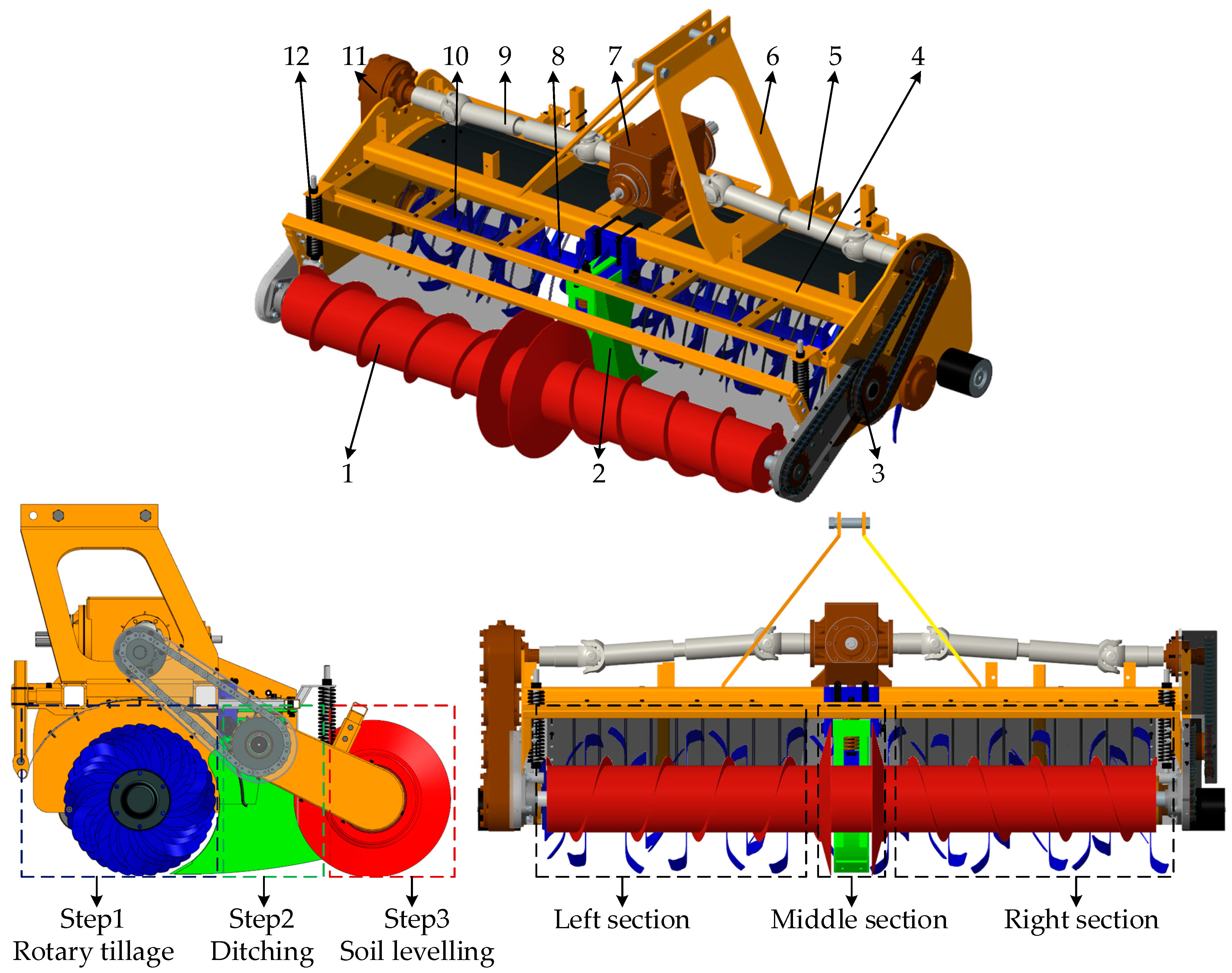
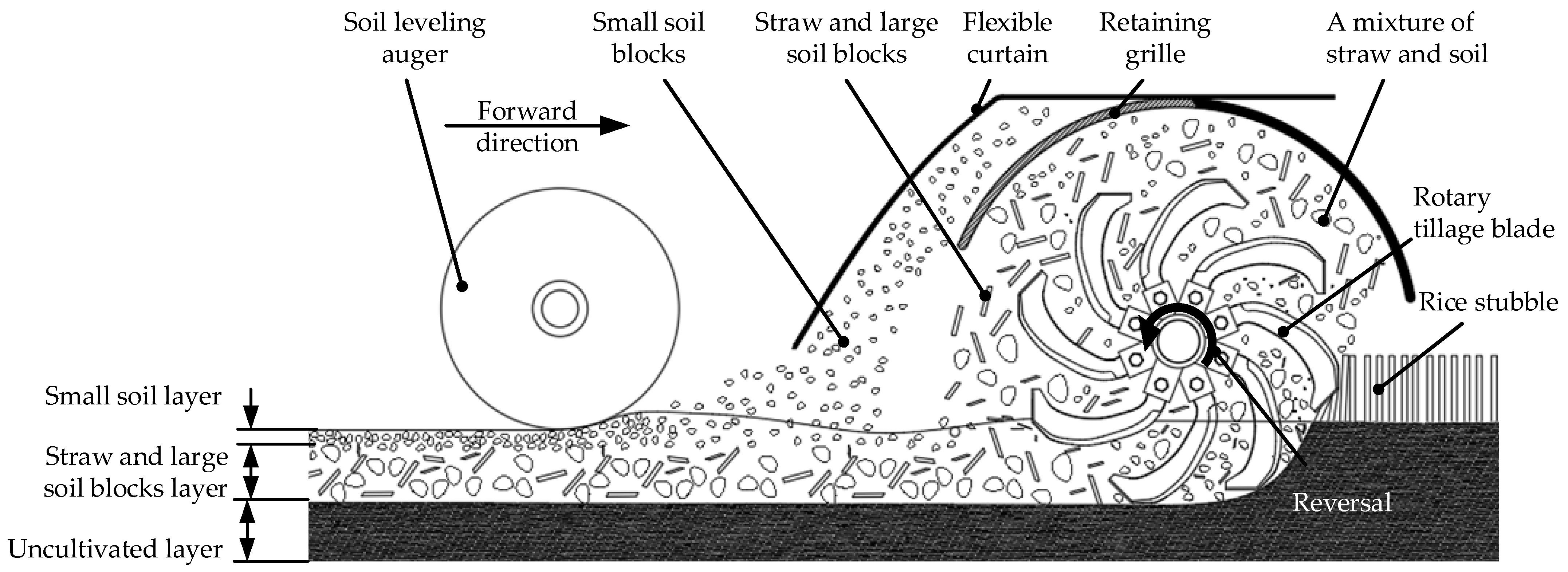

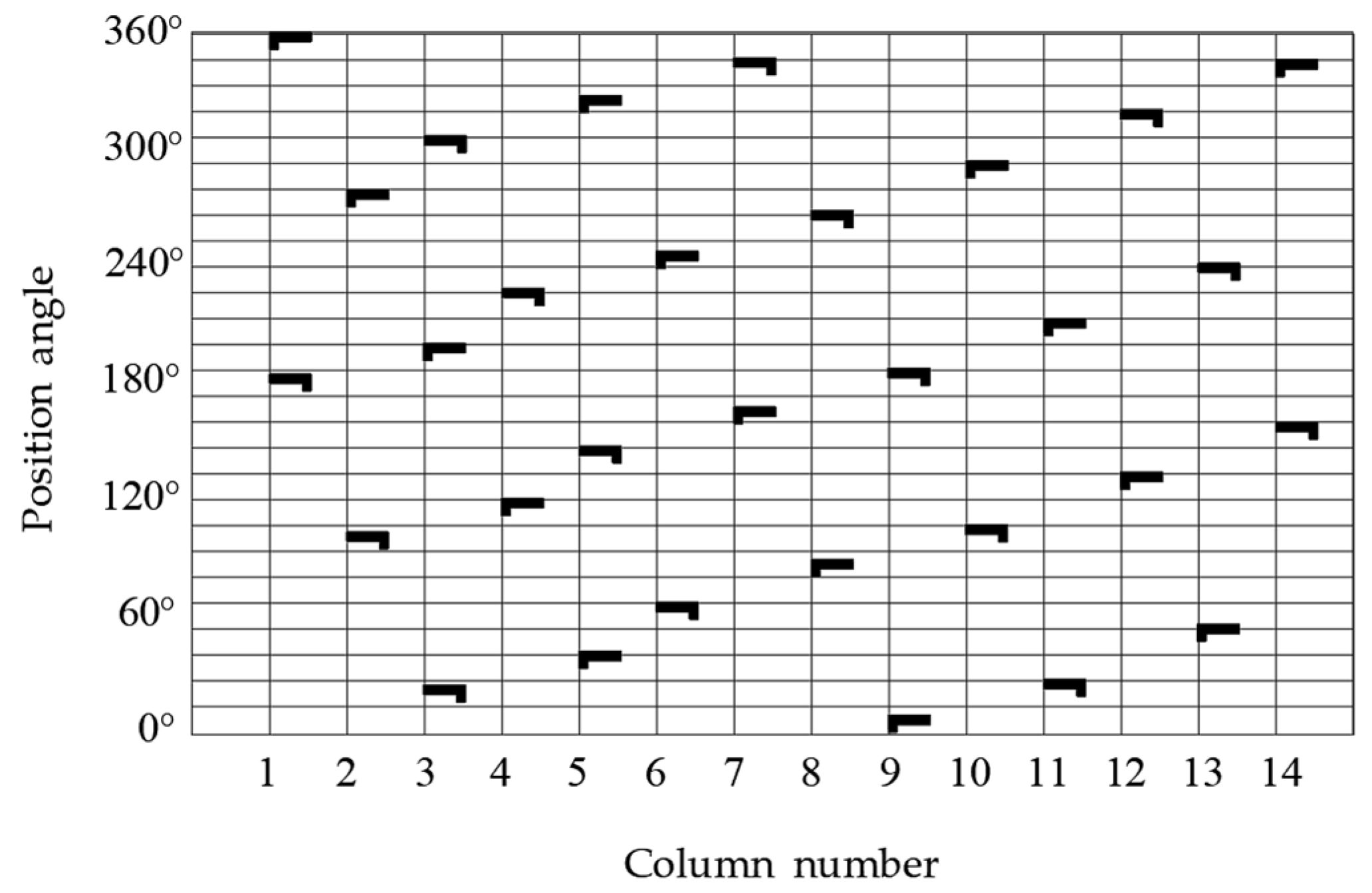
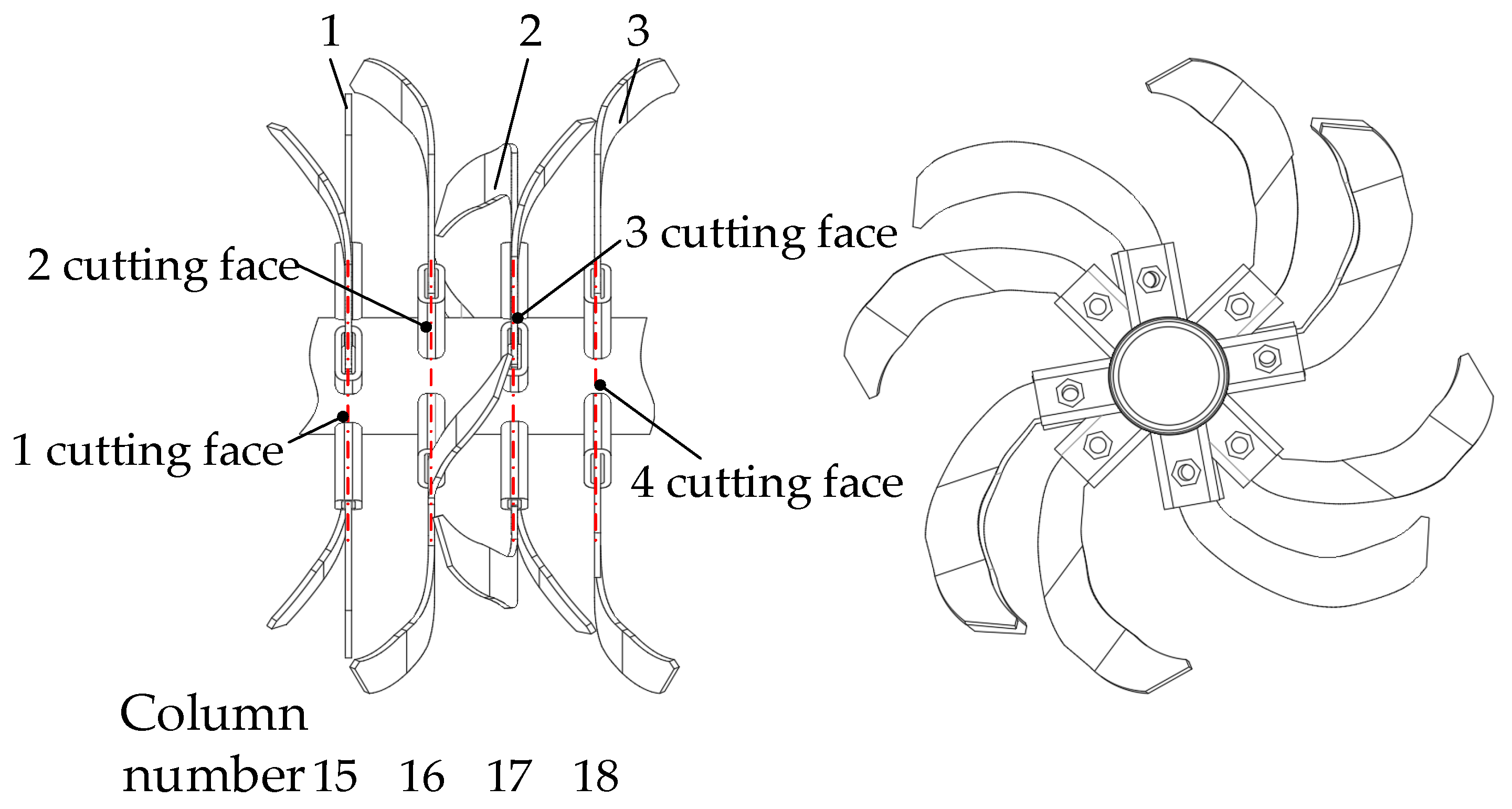
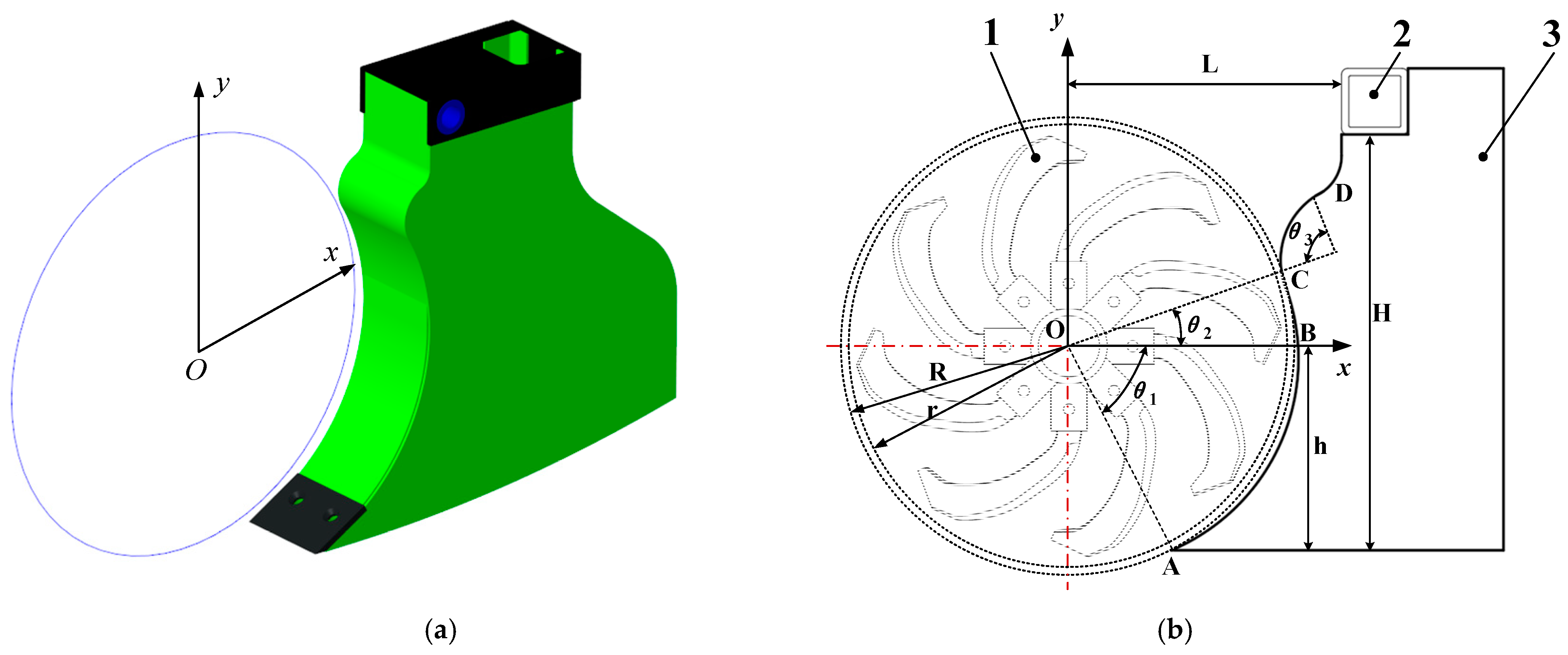


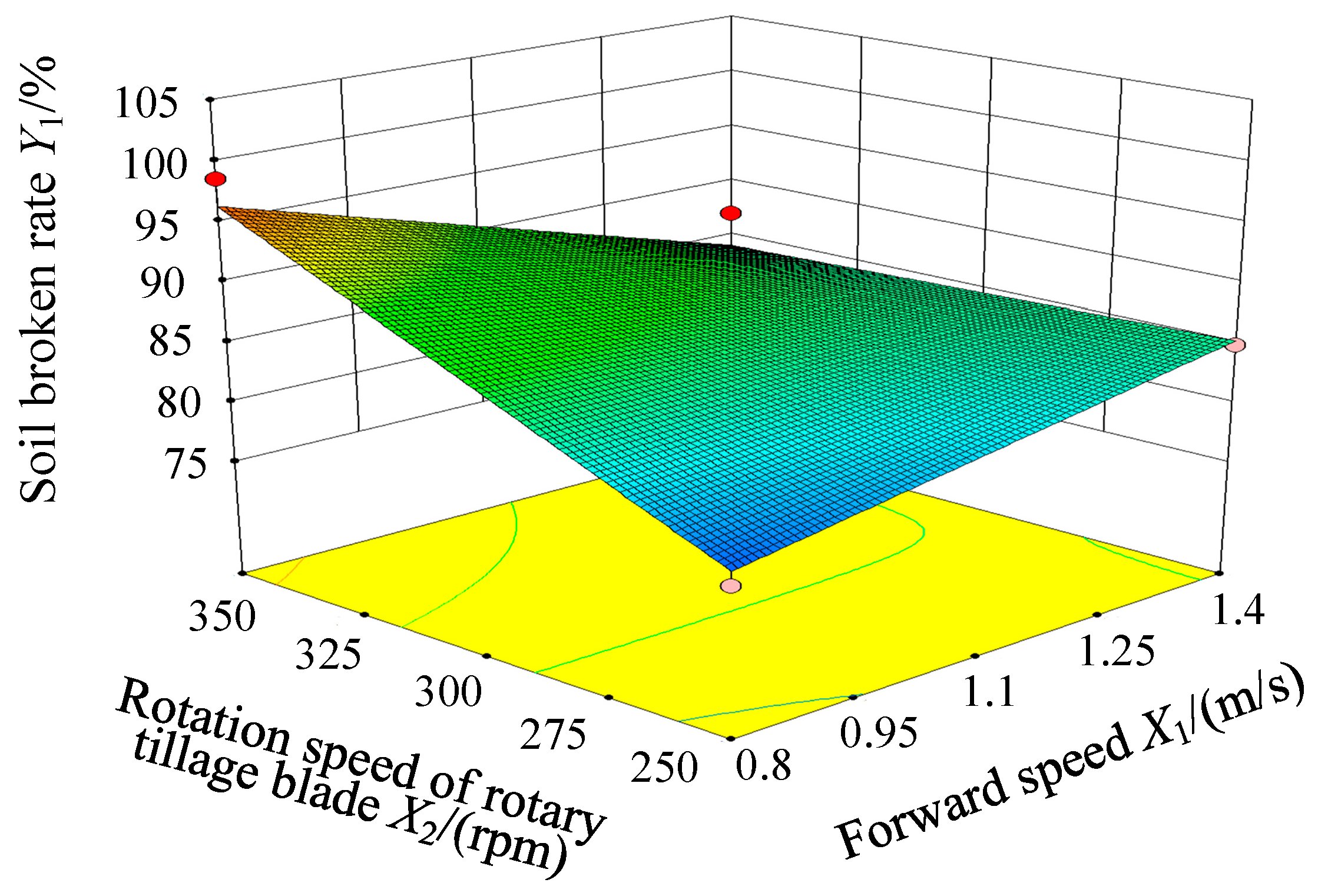


| Parameter | Value | |
|---|---|---|
| Dimensions (mm) | 2550 × 1200 × 1290 | |
| Machine weight (kg) | 1120 | |
| Matched power (kW) | ≥73.5 | |
| PTO (r/min) | 540/720 | |
| Working speed (m·s−1) | 0.8~1.6 | |
| Working width (mm) | Rotary tilling width | 2300 |
| Ditching width | Top: 220~230, Bottom: 120~130, | |
| Working depth (mm) | Rotary tilling depth | 100~150 |
| Ditching depth | 130~160 | |
| Rotation speed of rotary tillage blade (rpm) | 210–540 | |
| Rotary tillage blade type | IS225, IS245 | |
| Rotary tillage blade number | 76 | |
| Rotation speed of soil leveling auger (rpm) | 100~300 (Infinite speed variation) | |
| Factor | Forward Speed X1 (m·s−1) | Rotation Speed of Rotary Tillage Blade Roller X2 (rpm) | Rotation Speed of Soil Leveling Auger X3 (rpm) | |
|---|---|---|---|---|
| Level | ||||
| −1 | 0.8 | 250 | 180 | |
| 0 | 1.1 | 300 | 210 | |
| 1 | 1.4 | 350 | 240 | |
| Test Scheme | Test Result | |||||
|---|---|---|---|---|---|---|
| Test Number | Forward Speed X1 (m·s−1) | Rotation Speed of Rotary Tillage Blade Roller X2 (rpm) | Rotation Speed of Soil Leveling Auger X3 (rpm) | Soil Breaking Rate Y1 (%) | Straw Coverage Rate Y2 (%) | Soil Flatness Y3 (mm) |
| 1 | 1.4 | 250 | 210 | 84.95 | 87.62 | 10.8 |
| 2 | 1.4 | 300 | 180 | 82.32 | 91.73 | 8.0 |
| 3 | 1.1 | 250 | 240 | 85.25 | 88.49 | 9.4 |
| 4 | 0.8 | 350 | 210 | 98.61 | 91.92 | 9.9 |
| 5 | 0.8 | 300 | 180 | 89.99 | 92.41 | 6.1 |
| 6 | 1.1 | 350 | 240 | 86.06 | 93.3 | 8.3 |
| 7 | 1.4 | 350 | 210 | 87.1 | 89.18 | 8.9 |
| 8 | 1.1 | 350 | 180 | 95.27 | 91.53 | 10.2 |
| 9 | 0.8 | 300 | 240 | 80.5 | 94.18 | 9.8 |
| 10 | 1.1 | 300 | 210 | 84.03 | 93.98 | 19.2 |
| 11 | 1.4 | 300 | 240 | 81.28 | 92.41 | 7.8 |
| 12 | 1.1 | 250 | 180 | 85.86 | 90.55 | 6.9 |
| 13 | 0.8 | 250 | 210 | 77.12 | 89.08 | 9.6 |
| Variation Source | Sum of Squares | DF | Mean Square | F Value | p Value |
|---|---|---|---|---|---|
| Model | 338.89 | 6 | 56.48 | 4.60 | 0.0428 |
| X1 | 13.97 | 1 | 13.97 | 1.14 | 0.3272 |
| X2 | 143.31 | 1 | 143.31 | 11.67 | 0.0142 * |
| X3 | 51.77 | 1 | 51.77 | 4.22 | 0.0858 |
| X1X2 | 93.51 | 1 | 93.51 | 7.62 | 0.0329 * |
| X1X3 | 17.85 | 1 | 17.85 | 1.45 | 0.2733 |
| X2X3 | 18.49 | 1 | 18.49 | 1.51 | 0.2657 |
| Residual | 73.67 | 6 | 12.28 | ||
| Cor total | 412.56 | 12 |
| Variation Source | Sum of Squares | DF | Mean Square | F Value | p Value |
|---|---|---|---|---|---|
| Model | 52.40 | 9 | 5.82 | 11.18 | 0.0360 |
| X1 | 5.53 | 1 | 5.53 | 10.61 | 0.0472 * |
| X2 | 12.98 | 1 | 12.98 | 24.92 | 0.0155 * |
| X3 | 0.58 | 1 | 0.58 | 1.12 | 0.3677 |
| X1X2 | 0.41 | 1 | 0.41 | 0.79 | 0.4405 |
| X1X3 | 0.30 | 1 | 0.30 | 0.57 | 0.5051 |
| X2X3 | 3.67 | 1 | 3.67 | 7.04 | 0.0768 |
| X12 | 4.53 | 1 | 4.53 | 8.69 | 0.0601 |
| X22 | 22.29 | 1 | 22.29 | 42.78 | 0.0073 * |
| X32 | 0.03 | 1 | 0.03 | 0.05 | 0.8326 |
| Residual | 1.56 | 3 | 0.52 | ||
| Cor total | 53.97 | 12 |
| Variation Source | Sum of Squares | DF | Mean Square | F Value | p Value |
|---|---|---|---|---|---|
| Model | 118.78 | 9.00 | 13.20 | 13.81 | 0.0267 |
| X1 | 0.00 | 1.00 | 0.00 | 0.00 | 0.9734 |
| X2 | 0.05 | 1.00 | 0.05 | 0.05 | 0.8421 |
| X3 | 2.10 | 1.00 | 2.10 | 2.20 | 0.2348 |
| X1X2 | 1.21 | 1.00 | 1.21 | 1.27 | 0.3424 |
| X1X3 | 3.80 | 1.00 | 3.80 | 3.98 | 0.1401 |
| X2X3 | 4.84 | 1.00 | 4.84 | 5.06 | 0.1099 |
| X12 | 59.16 | 1.00 | 59.16 | 61.89 | 0.0043 * |
| X22 | 42.51 | 1.00 | 42.51 | 44.47 | 0.0069 * |
| X32 | 87.51 | 1.00 | 87.51 | 91.55 | 0.0024 * |
| Residual | 2.87 | 3.00 | 0.96 | ||
| Cor total | 121.65 | 12.00 |
| Test Scheme | Test Result | |||||
|---|---|---|---|---|---|---|
| Test Number | Forward Speed (X1) | Rotation Speed of Rotary Tillage Blade Roller (X2) | Rotation Speed of Soil Leveling Auger (X3) | Soil Breaking Rate (Y1) | Straw Coverage Rate (Y2) | Soil Flatness (Y3) |
| 1 | 0.94 m·s−1 | 268 rpm | 204 rpm | 91.83% | 92.86% | 6.54 mm |
| 2 | 92.31% | 92.70% | 8.33 mm | |||
| 3 | 92.04% | 93.48% | 10.17 mm | |||
| Mean value | 92.06% | 93.01% | 8.35 mm | |||
| Predicted value | 92.27% | 93.68% | 8.85 mm | |||
| Model error | - | - | - | 0.23% | 0.72% | 5.65% |
Publisher’s Note: MDPI stays neutral with regard to jurisdictional claims in published maps and institutional affiliations. |
© 2022 by the authors. Licensee MDPI, Basel, Switzerland. This article is an open access article distributed under the terms and conditions of the Creative Commons Attribution (CC BY) license (https://creativecommons.org/licenses/by/4.0/).
Share and Cite
Jiang, L.; Tang, Q.; Wu, J.; Yu, W.; Zhang, M.; Jiang, D.; Wei, D. Design and Test of Seedbed Preparation Machine before Transplanting of Rapeseed Combined Transplanter. Agriculture 2022, 12, 1427. https://doi.org/10.3390/agriculture12091427
Jiang L, Tang Q, Wu J, Yu W, Zhang M, Jiang D, Wei D. Design and Test of Seedbed Preparation Machine before Transplanting of Rapeseed Combined Transplanter. Agriculture. 2022; 12(9):1427. https://doi.org/10.3390/agriculture12091427
Chicago/Turabian StyleJiang, Lan, Qing Tang, Jun Wu, Wenyi Yu, Min Zhang, Dong Jiang, and Dexin Wei. 2022. "Design and Test of Seedbed Preparation Machine before Transplanting of Rapeseed Combined Transplanter" Agriculture 12, no. 9: 1427. https://doi.org/10.3390/agriculture12091427
APA StyleJiang, L., Tang, Q., Wu, J., Yu, W., Zhang, M., Jiang, D., & Wei, D. (2022). Design and Test of Seedbed Preparation Machine before Transplanting of Rapeseed Combined Transplanter. Agriculture, 12(9), 1427. https://doi.org/10.3390/agriculture12091427






